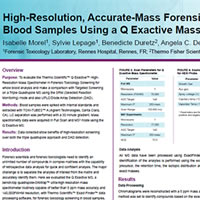
High-Resolution, Accurate-Mass Forensic Toxicology Screening in Blood Samples Using a Q Exactive Mass Spectrometer Authors: Isabelle Morel1, Sylvie Lepage1, Benedicte Duretz2, Angela C. De Pietro3 Email (angela.pietro@novanalitica.com.br) 1Forensic Toxicology Laboratory, Rennes Hospital, Rennes, France; 2Thermo Fisher Scientific, Les Ulis, France; 3Nova Anal�tica, S�o Paulo, SP, BR
|
Resumo do Pôster:Forensic scientists and forensic toxicologists need to identify an unlimited number of compounds in complex matrixes with the capability of retrospective data analysis for quick and confident analysis. The major challenge is to separate the analytes of interest from the matrix and accurately identify them. In this work a bench-top quadrupole-Orbitrap™ ultra-high resolution mass spectrometer routinely capable of better than 5 ppm mass accuracy and 140,000 FWHM resolution was evaluated with Thermo Scientific™ ExactFinder™ 2.0 data processing software, for forensic toxicology screening in blood samples. A comparison with Targeted Screening on a Triple Quadrupole MS using the SRM (Selected Reaction Monitoring) mode and also UPLC/Diode Array Detection (DAD) was done. Thirty-nine samples were analyzed and compared using the 3 different technologies. We have been able to identify 143 compounds with the HRAM approach, 121 with the 6 targeted forensic screening methods on the triple quadrupole MS and 69 compounds by DAD. Fewer analytes have been identified using DAD despite the 612 analytes in the library. Sensitivity is the main concern with this technique. Moreover, DAD may provide some false results. For ex.: estazolam has been identified in DAD but not confirmed by the MS technologies; alprazolam was not detected with DAD but was confirmed by the other 2 approaches. The HRAM LC-MS/MS approach identified the largest number of compounds for forensic toxicology with the 650 analytes library. This HRAM method also allows for retrospective data analysis. Data collected by this approach show benefits of high-resolution screening over both the triple quadrupole approach and DAD detection. |
